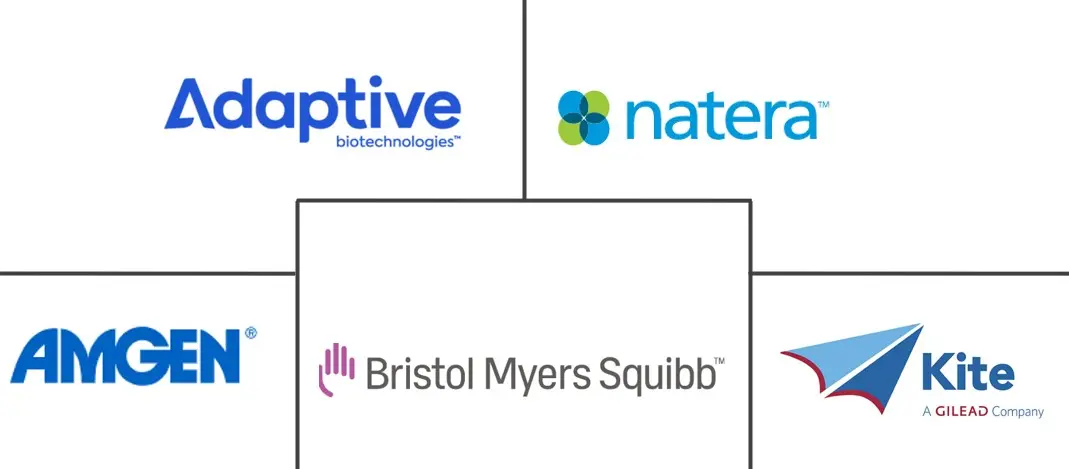Global Minimal Residual Disease Market Size and Share
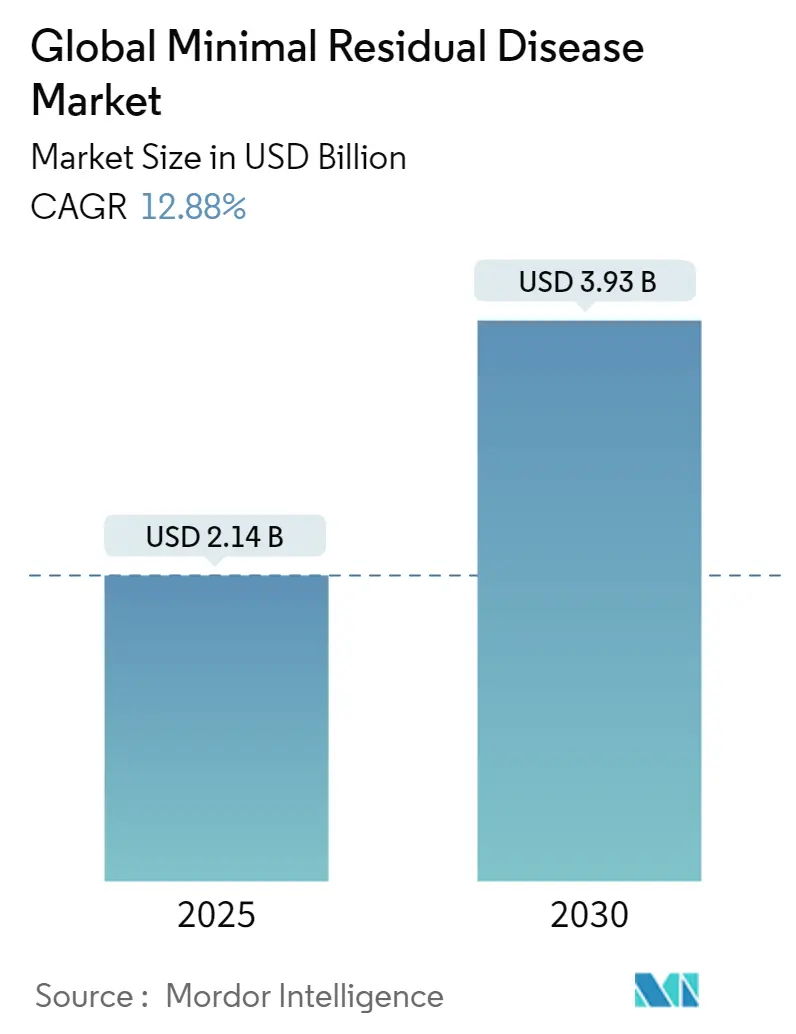
Global Minimal Residual Disease Market Analysis by Mordor Intelligence
The Global Minimal Residual Disease Market size is estimated at USD 2.14 billion in 2025, and is expected to reach USD 3.93 billion by 2030, at a CAGR of 12.88% during the forecast period (2025-2030).
The COVID-19 pandemic affected healthcare systems globally and resulted in the interruption of usual care in many healthcare facilities, exposing vulnerable patients with cancer to significant risks. Since the beginning of the COVID-19 pandemic, measures have been taken to increase the admissions of covid patients and reduce the number of non-covid patients in the hospitals, leading to postponing the treatment. A study titled 'Impact of the COVID-19 Pandemic on Cancer Care: A Global Collaborative Study' in September 2020 reported that a total of 356 centers from 54 countries across six continents participated between April 21 and May 8, 2020. These centers serve 716,979 new patients with cancer a year. Most of them (88.2%) reported facing challenges in delivering care during the pandemic. Although 55.34% reduced services as part of a preemptive strategy, other common reasons included an overwhelmed system (19.94%), lack of personal protective equipment (19.10%), and staff shortage (17.98%), and restricted access to medications (9.83%). According to an article titled 'What is the Clinical Impact of COVID-19 on Cancer Patients?' in June 2020, the increased vulnerability of cancer patients to COVID-19, particularly to the severe effects of this infectious disease, has led some patients to delay or pause their anti-cancer treatments to reduce their exposure to potentially infected people, and this condition during initial pandemic phase affected the market adversely. Such studies indicate that cancer care was severely impacted, subsequently impacting the market growth. Hence, there is an overall negative impact of the COVID-19 pandemic on the market's growth.
The factors propelling the growth of the minimal residual disease market are the rising prevalence of various types of cancer worldwide and the increasing awareness among people to confirm the presence of carcinogens. The patients undergoing continued cancer treatment are expected to be the most important element driving the minimal residual disease market forward. In addition, the rising adoption of personalized medicines for the treatment and rising research and development activities contribute to the market's growth.
The increasing number of people suffering from various cancers is the key driving factor for the minimal residual disease market growth. For instance, as per the American Society of Clinical Oncology February 2021 report, an estimated 235,760 adults (119,100 men and 116,6600 women) in the United States were expected to be diagnosed with lung cancer. For instance, Globocan, 2020, it found that there are 18.3% new cases of cancers in India, and cervical cancer accounted for 9.4% of all cancers. For instance, according to statistics published by the American Cancer Society (ACS) updates from January 2022, approximately 26,560 new cases of stomach cancer are projected to be detected in the United States in 2021, with 16,160 males and 10,400 women. According to the statistics published by the National Breast Cancer Foundation, in July 2021, approximately 63% of breast cancer patients have been diagnosed with local-stage breast cancer, 27% with regional stage, and 6% with a distant (metastatic) disease.
In addition, the rising prevalence of blood cancer worldwide increases the demand for better treatment options and accuracy in removing the residual cancerous cells, which is likely to increase the demand for a minimal residual disease market. According to the statistics published by the American Cancer Society, in January 2022, 34,920 new cases of multiple myeloma were estimated to be diagnosed in the United States.
However, the high cost of research and development activities will likely hinder the market's growth over the forecast period.
Global Minimal Residual Disease Market Trends and Insights
Next Generation Sequencing (NGS) Segment Expects to Register a Highest CAGR in the Forecast Period
Next-generation sequencing is a technology used to determine the sequence of DNA or RNA to study the genetic variations associated with the disease. It is also called as massively-parallel sequencing as it enables the sequencing to determine the sequencing of many DNA at a particular time.
The factors propelling the growth of next-generation sequencing technology are increasing incidences of cancer globally, rising demand for next-generation sequencing services and applications in drug development, clinical procedures, precision medicines, and adoption of the latest technology established for next-generation sequencing.
Recently, new assays, including next-generation sequencing, were developed to monitor minimal residual disease more precisely in the patients. Next-Generation Sequencing offers greater sensitivity than conventionally employed morphologic and cytogenetic tests. According to an article published by the Journal of Molecular Diagnostics in January 2020, titled 'A New Next-Generation Sequencing Strategy for the Simultaneous Analysis of Mutations and Chromosomal Rearrangements at DNA Level in Acute Myeloid Leukemia Patients' it has been found that the next-generation sequencing offers the promise of detecting all genomic lesions in a single run. In addition, next-generation sequencing applies to every newly diagnosed acute myeloid leukemia because of the frequent prevalence of multiple molecular aberrations among patients.
The introduction of various error-corrected next-generation methodologies has made the detection of minimal residual diseases easy. Molecular barcoding has recently been used to develop several error-corrected next-generation sequencing approaches based on barcoding the individual DNA molecules used for next-generation sequencing library creation. According to an article published by the National Center for Biotechnology Information in June 2021, titled "Minimal Residual Disease Monitoring with Next-Generation Sequencing," it has been found that next-generation sequencing has the potential to reduce the prevalence of undiagnosed minimal residual diseases, allowing for early management, which is critical for Acute lymphocytic leukemia (ALL) patient survival.
Moreover, the companies' investment in research and development activities, adoption of advanced technology, and increasing their focus on developing assays to assess minimal residual disease are likely to increase the growth of next-generation sequencing over the forecast period. For instance, in January 2020, Adaptive Biotechnologies collaborated with GlaxoSmithKline to use its clonoSEQ Assay to assess minimal residual disease (MRD) in GSK's portfolio of hematology products.
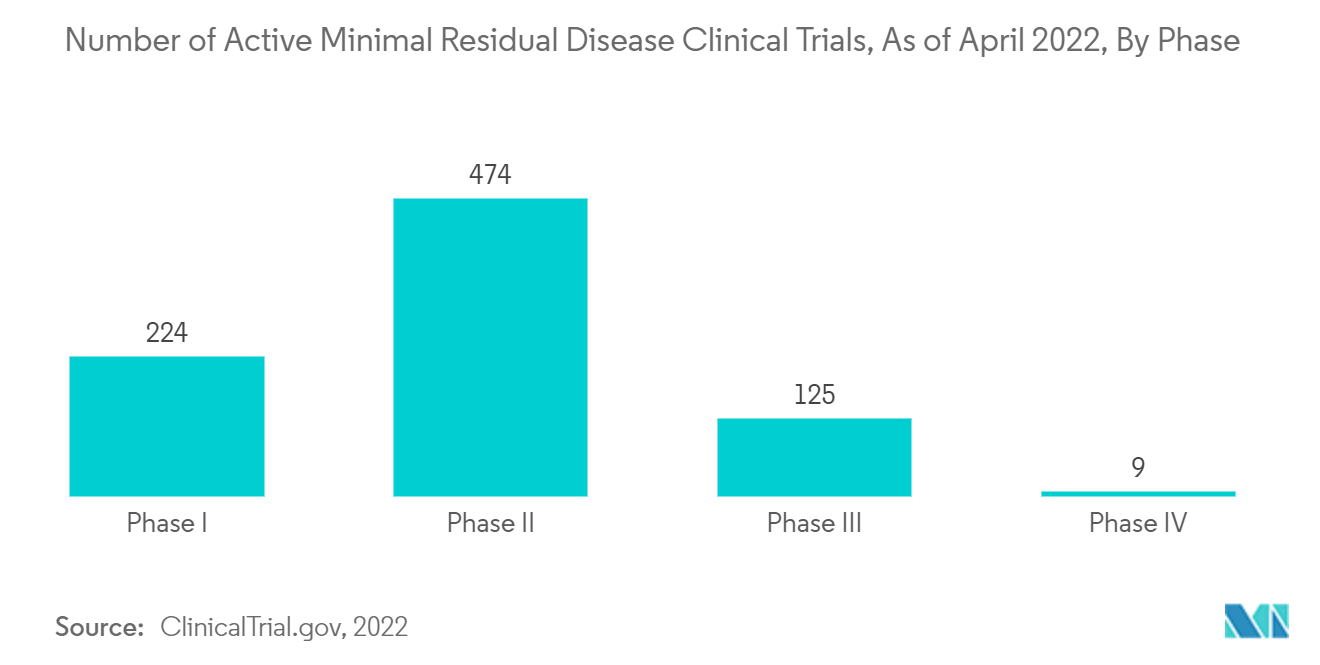
North America is Expected to Have the Significant Market Share during the Forecast Period
The increasing incidences of cancer, rising demand for next-generation and polymerase chain reaction techniques for detecting minimal residual diseases, adoption of the latest technology, and established research infrastructure for proteomics, genomics, and oncology are the factors propelling the growth of the market in the North American region.
The increasing incidences and prevalence of hematological cancers in the United States have increased the risk of people having residual cancerous cells, which is likely to increase the demand for minimal residual disease market. According to the statistics published by the American Cancer Society 2022, 34,470 new cases of multiple myeloma in the United States in 2022. In addition, as per the same source, about 6,660 new cases of acute lymphocytic leukemia (ALL) in 2022. As per the statistics published by the Leukemia and Lymphoma Society, in 2021, 90,390 new lymphoma cases were expected to be diagnosed in patients in the United States, of which 8,830 cases would be of Hodgkin lymphoma and 81,560 cases of non-Hodgkin lymphoma.
Moreover, the increasing focus of the companies on developing treatments and tests for detecting minimal residual disease is also contributing to the market's growth. For instance, in February 2022, Invitae launched a study to generate real-world data on personalized minimal residual disease tests across various tumor types. Similarly, in April 2020, Inivata launched an assay, RaDaR, to detect and monitor residual disease and recurrence in the plasma samples of patients previously diagnosed with cancer. The RaDaR assay is built on Inivata's proven InVision liquid biopsy platform technology, a next-generation sequencing platform that incorporates built-in controls and error correction for highly sensitive and specific variant detection.
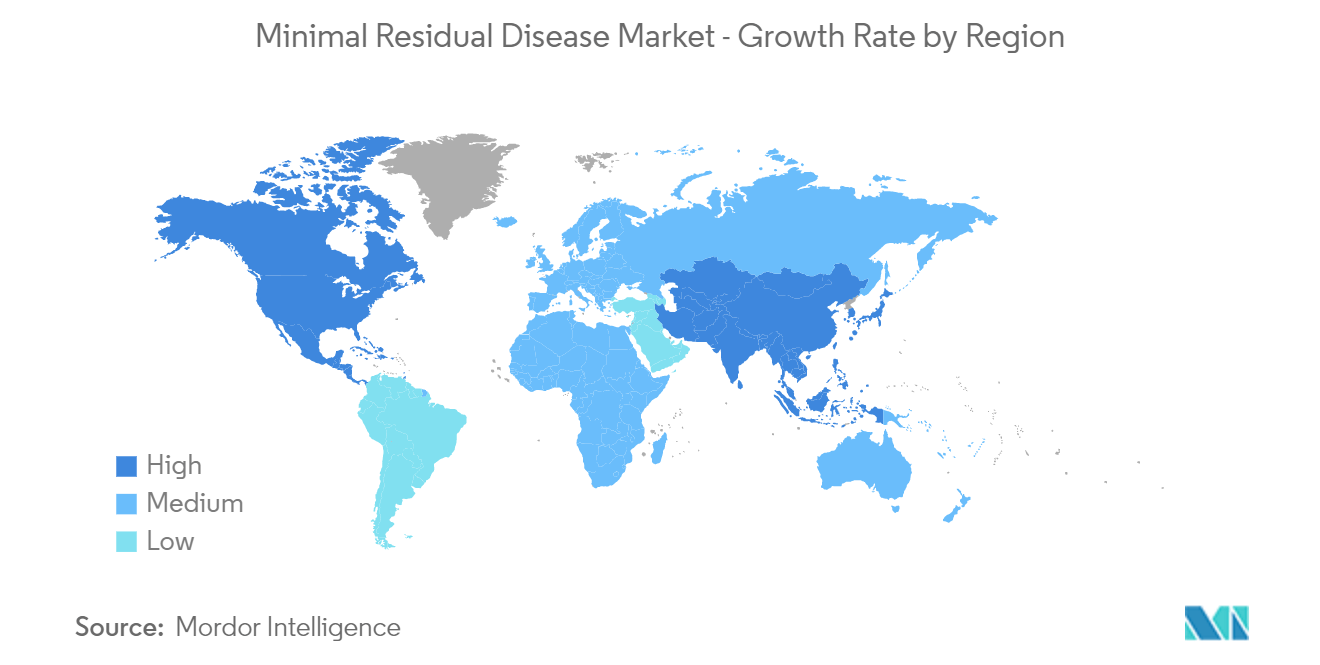
Competitive Landscape
The minimal residual disease market is highly competitive and consists of several major players. The companies are investing in research and development activities to provide patients with better treatment and detection methods and adopt various business strategies such as collaboration and acquisitions to withhold their positions in the market. Some key players are Adaptive Biotechnologies, Bristol-Myers Squibb Company, Natera, Kite Pharma, and Amgen Inc.
Global Minimal Residual Disease Industry Leaders
-
Adaptive Biotechnologies
-
Bristol-Myers Squibb Company
-
Kite Pharma
-
Natera
-
Amgen Inc.
- *Disclaimer: Major Players sorted in no particular order
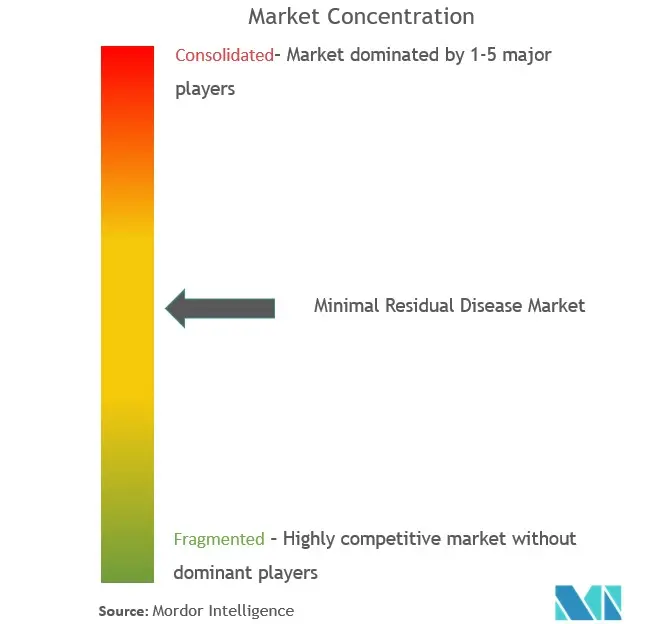
Recent Industry Developments
- In February 2022, Personalis announced a strategic collaboration with the Moores Cancer Center at the University of California San Diego Health, a National Cancer Institute-designated Comprehensive Cancer Center, to support clinical diagnostic testing in patients with advanced solid tumors and hematological malignancies. The collaboration will include research studies for high sensitivity minimal residual disease (MRD) and cancer recurrence detection with a newly launched liquid biopsy assay.
- in February 2022, Invitae launched a study to generate real-world data on personalized minimal residual disease tests across various tumor types.
Global Minimal Residual Disease Market Report Scope
As per the scope of the report, the minimal residual disease is the presence of a small number of cancer cells in the body following therapy. These cells have the potential to recur in cancer patients and induce relapse. The Global Minimal Residual Disease Market is segmented by test technique (Polymerase Chain Reaction, Fluorescence In Situ Hybridization (FISH), and Next Generation Sequencing (NGS)), target detection (Leukemia, Lymphoma, Solid Tumors, and Others), by end-user (Hospitals, Laboratory centers, and Specialty Clinics) and geography (North America, Europe, Asia-Pacific, Middle-East and Africa, South America). The market report also covers the estimated market sizes and trends for 17 countries across major global regions. The report offers the value (USD million) for the above segments.
| Polymerase Chain Reaction |
| Fluorescence In Situ Hybridization (FISH) |
| Next Generation Sequencing (NGS) |
| Leukemia |
| Lymphoma |
| Solid Tumors |
| Others |
| Hospitals |
| Laboratory centers |
| Specialty Clinics |
| North America |
| Europe |
| Asia-Pacific |
| Middle-East and Africa |
| South America |
| By Test Technique | Polymerase Chain Reaction |
| Fluorescence In Situ Hybridization (FISH) | |
| Next Generation Sequencing (NGS) | |
| By Detection Target | Leukemia |
| Lymphoma | |
| Solid Tumors | |
| Others | |
| By End-user | Hospitals |
| Laboratory centers | |
| Specialty Clinics | |
| Geography | North America |
| Europe | |
| Asia-Pacific | |
| Middle-East and Africa | |
| South America |
Key Questions Answered in the Report
How big is the Global Minimal Residual Disease Market?
The Global Minimal Residual Disease Market size is expected to reach USD 2.14 billion in 2025 and grow at a CAGR of 12.88% to reach USD 3.93 billion by 2030.
What is the current Global Minimal Residual Disease Market size?
In 2025, the Global Minimal Residual Disease Market size is expected to reach USD 2.14 billion.
Who are the key players in Global Minimal Residual Disease Market?
Adaptive Biotechnologies, Bristol-Myers Squibb Company, Kite Pharma, Natera and Amgen Inc. are the major companies operating in the Global Minimal Residual Disease Market.
Which is the fastest growing region in Global Minimal Residual Disease Market?
Asia-Pacific is estimated to grow at the highest CAGR over the forecast period (2025-2030).
Which region has the biggest share in Global Minimal Residual Disease Market?
In 2025, the North America accounts for the largest market share in Global Minimal Residual Disease Market.
What years does this Global Minimal Residual Disease Market cover, and what was the market size in 2024?
In 2024, the Global Minimal Residual Disease Market size was estimated at USD 1.86 billion. The report covers the Global Minimal Residual Disease Market historical market size for years: 2019, 2020, 2021, 2022, 2023 and 2024. The report also forecasts the Global Minimal Residual Disease Market size for years: 2025, 2026, 2027, 2028, 2029 and 2030.
Page last updated on:
Global Minimal Residual Disease Market Report
Statistics for the 2025 Global Minimal Residual Disease market share, size and revenue growth rate, created by Mordor Intelligence™ Industry Reports. Global Minimal Residual Disease analysis includes a market forecast outlook for 2025 to 2030 and historical overview. Get a sample of this industry analysis as a free report PDF download.
